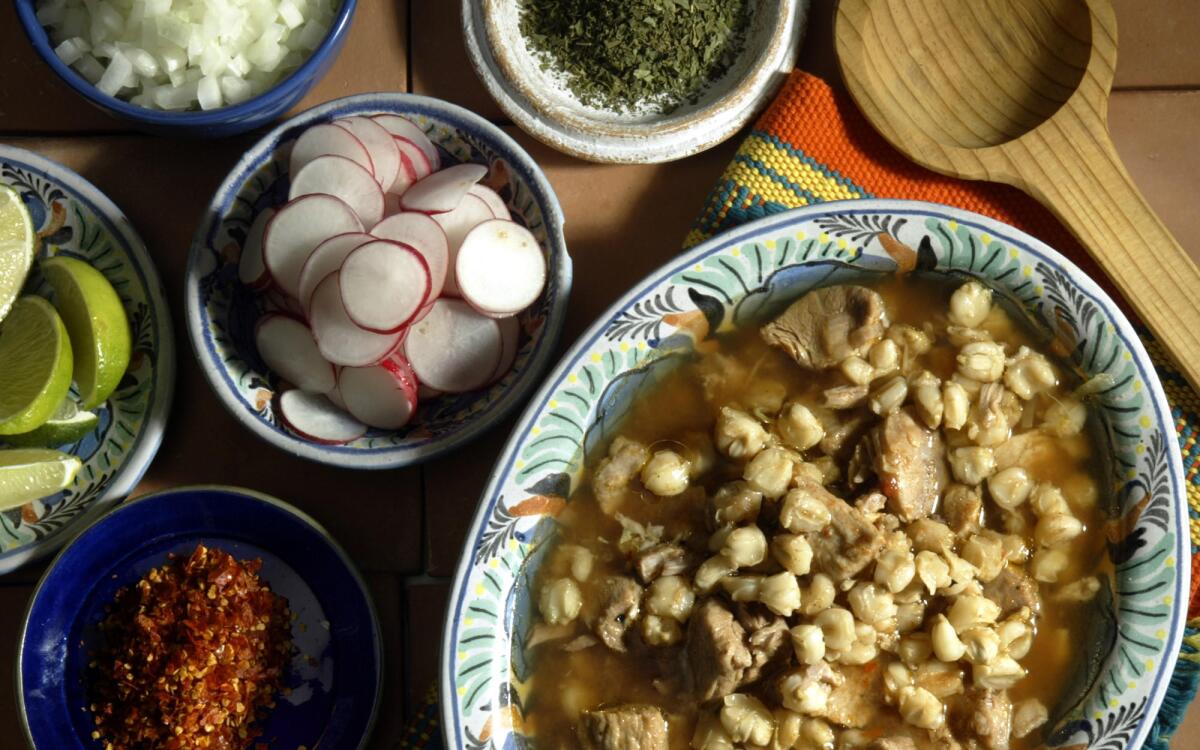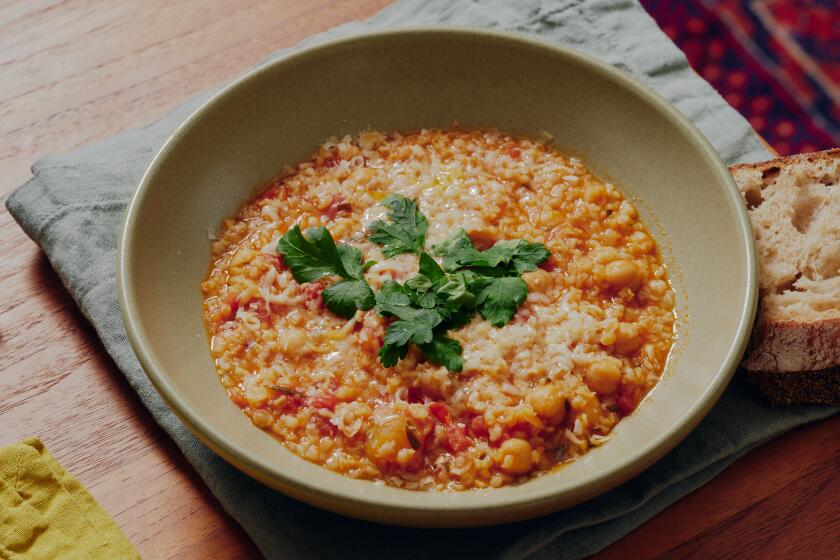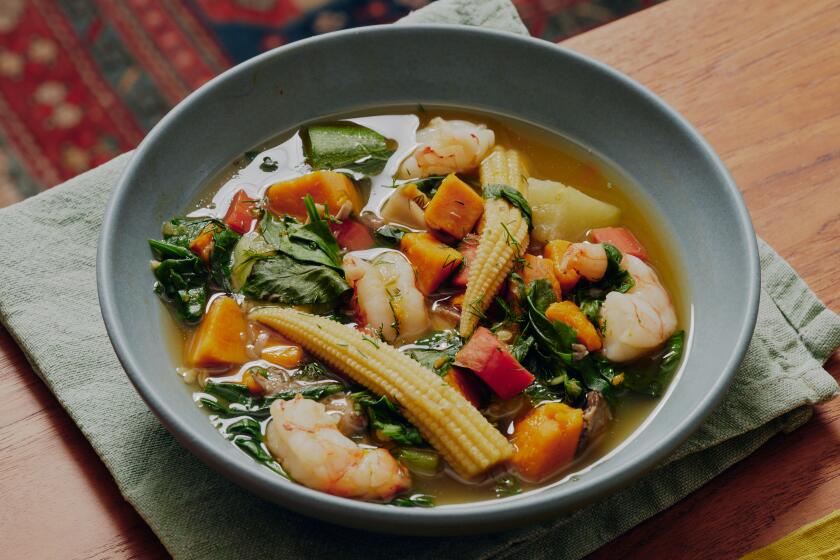Pozole Estilo Jalisco (Jalisco-style red pozole)

Pozole is the perfect party dish â easy to make, impressively showy and fun to eat â so it turns up at celebrations in Mexico from Independence Day to birthdays, weddings and baptisms.
And we think this big, soupy bowl of hominy and chiles is a perfect Super Bowl feast: a one-dish meal that you can make in advance, reheat and set out in a pot for people to help themselves.
Pozole is party food because the dish isnât complete until each diner splashes on more colors and flavors from an array of condiments. A squeeze of lime adds the zing of authority. Dried oregano crumbled into the hot soup sends out an intense herbal aroma. Dried or fresh chiles or a hot chile salsa spice it up. Chopped onion is a must. Shredded cabbage or lettuce give a cool crunch, and sliced radishes add a striking dash of red and white. Crisp, golden-brown tortillas already made into tostada bases are the traditional accompaniment.
What makes pozole distinctive is the main ingredient â dried corn. But you donât have to worry about the tedious job of cooking the corn from scratch and removing the hulls to make hominy. All you have to do is go to a tortilleria, or, even easier, any large supermarket that caters to Latinos, and buy a sack of nixtamal.
Nixtamal is dried corn cooked with food-grade lime until it can be hulled. The softened, cooked corn can then be ground into masa for tortillas or tamales. Or it is left whole and cooked further to make pozole.
Some people substitute canned hominy, but why do that when cooking nixtamal is so easy?
You just put the corn in a pot, add water and simmer until the kernels burst forth like flowers. (American-style canned hominy is processed with a different alkali so its flavor is not quite the same. However, Mexican-style canned hominy brands such as Juanitaâs and El Mexicano are processed in the traditional manner.)
Supermarkets that stock Latino foods usually carry both canned Mexican-style hominy and fresh nixtamal. Packed in two- and five-pound bags, nixtamal is usually in the refrigerated deli section, along with fresh masa. It also is available at most tortillerias.
As the nixtamal cooks, a warm, earthy aroma envelops the kitchen. If youâve ever walked past a tortilleria that is open to the street and at peak production, you know the fragrance. So cooking this dish is as pleasurable as eating it.
Thereâs no single recipe for pozole. What goes into the pot besides corn varies from place to place in Mexico, so there are different versions: green pozole in Colima, red or white pozole in Jalisco, seafood pozole in Veracruz and on the coast of Oaxaca. Pueblo Indians in the United States have their own versions.
Pork is the most popular pozole meat today, although the indigenous inhabitants of Mexico made pozole long before the Spaniards arrived and introduced pigs.
Most Mexican restaurants in Southern California serve red pozole with pork. I never saw green pozole until I took cooking classes in Guanajuato at the Academia Falcon, where I was studying Spanish.
Working in a quaint, tiled kitchen, we blended poblano chiles with cilantro and added that to the corn along with cooked chicken. The flavor is captivating, as appealing as green enchiladas. In the state of Guerrero, green pozole is thicker and contains tomatillos, explained our instructor, Luis Marhuani Marin Reyes.
For red pozole, we colored the broth with cascabel chiles ground with tomatoes, and added lean pork. Meat with bones gives the best flavor, Luis said, and some pozoles are made with cabeza (head) and pigâs feet.
When I tried the recipe at home, I bought pork labeled for pozole from a supermarket in downtown Los Angeles. That meat included pieces on the bone, but the woman behind the counter explained that some cooks add a little boneless pork stew meat, which makes the pozole easier to eat.
This red pozole recipe is adapted from the classes in Guanajuato.
From the 2004 story: âFlash of radish, splash of lime,â which in addition to this red pozole recipe included a recipe for Pozole Verde (Green Pozole).
Cut open the cascabel chiles and remove the seeds. Heat the oil in a small skillet over low heat. Add the chiles and cook, stirring, until fragrant, 3 to 4 minutes. Place in a bowl, cover with water and soak overnight. Before using, drain the chiles, discarding the water; remove the stems and any remaining seeds.
Place the nixtamal in a colander and rinse thoroughly. Place in a Dutch oven or heavy lidded pot and add the water. Slice 1 onion and add it to the pot along with the garlic cloves. Bring the mixture to a boil and boil gently, covered, 1 1/2 hours.
Meanwhile, place the tomatoes in a pan of boiling water and cook 2 minutes. Drain and allow to cool, then peel. Place the tomatoes and the chiles in a blender and puree. Set aside.
Remove the excess fat from the pork. The meat can remain in large chunks. When the nixtamal has boiled 1 1/2 hours, add the pork, the tomato-chile mixture and the salt. Cover and boil gently 1 1/2 hours longer.
Chop the 2 remaining onions. Arrange the chopped onions, lettuce, radishes, oregano, ground chile and lime wedges in serving bowls.
To serve, ladle the pozole into large soup bowls. Add the garnishes and squeeze in lime juice as desired, with tortillas to accompany.
Get our Cooking newsletter.
Your roundup of inspiring recipes and kitchen tricks.
You may occasionally receive promotional content from the Los Angeles Times.















